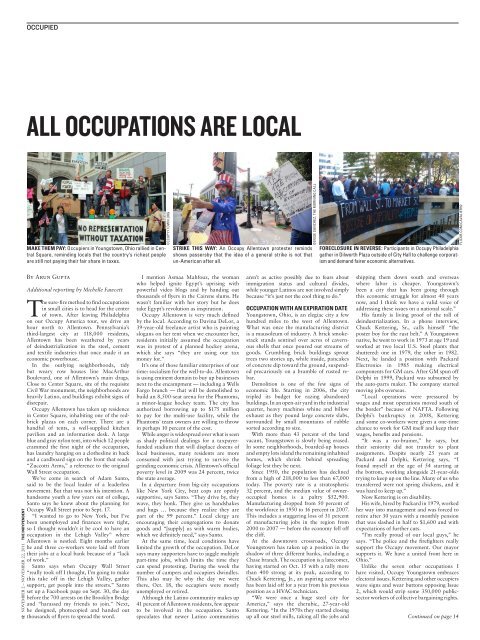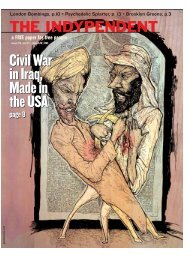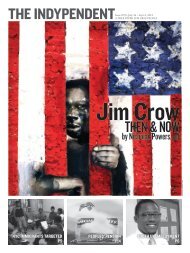once flourished - The Indypendent
once flourished - The Indypendent
once flourished - The Indypendent
- No tags were found...
Create successful ePaper yourself
Turn your PDF publications into a flip-book with our unique Google optimized e-Paper software.
OCCUPIEDALL OCCUPATIONS ARE LOCALMAKE THEM PAY: Occupiers in Youngstown, Ohio rallied in CentralSquare, reminding locals that the country’s richest peopleare still not paying their fair share in taxes.OCCUPYYTOWN.ORGSTRIKE THIS WAY: An Occupy Allentown protester remindsshows passersby that the idea of a general strike is not thatun-American after all.DENISE SANCHEZ, THE MORNING CALLFORECLOSURE IN REVERSE: Participants in Occupy Philadelphiagather in Dilworth Plaza outside of City Hall to challenge corporatismand demand fairer economic alternatives.FLICKR.COM/CAVALIER9212 NOVEMBER 2 – NOVEMBER 22, 2011 THE INDYPENDENTBy Arun GuptaAdditional reporting by Michelle Fawcett<strong>The</strong> sure-fire method to find occupationsin small cities is to head for the centerof town. After leaving Philadelphiaon our Occupy America tour, we drive anhour north to Allentown. Pennsylvania’sthird-largest city at 118,000 residents,Allentown has been weathered by yearsof deindustrialization in the steel, cementand textile industries that <strong>once</strong> made it aneconomic powerhouse.In the outlying neighborhoods, tidybut weary row houses line MacArthurBoulevard, one of Allentown’s main drags.Close to Center Square, site of the requisiteCivil War monument, the neighborhoods areheavily Latino, and buildings exhibit signs ofdisrepair.Occupy Allentown has taken up residencein Center Square, inhabiting one of the redbrickplazas on each corner. <strong>The</strong>re are ahandful of tents, a well-supplied kitchenpavilion and an information desk. A largeblue and gray nylon tent, into which 12 peoplecrammed the first night of the occupation,has laundry hanging on a clothesline in backand a cardboard sign on the front that reads“Zuccotti Arms,” a reference to the originalWall Street occupation.We’ve come in search of Adam Santo,said to be the local leader of a leaderlessmovement. But that was not his intention. Ahandsome youth a few years out of college,Santo says he knew about the planning forOccupy Wall Street prior to Sept. 17.“I wanted to go to New York, but I’vebeen unemployed and finances were tight,so I thought wouldn’t it be cool to have anoccupation in the Lehigh Valley” whereAllentown is nestled. Eight months earlierhe and three co-workers were laid off fromtheir jobs at a local bank because of a “lackof work.”Santo says when Occupy Wall Street“really took off I thought, I’m going to makethis take off in the Lehigh Valley, gathersupport, get people into the streets.” Santoset up a Facebook page on Sept. 30, the daybefore the 700 arrests on the Brooklyn Bridgeand “harassed my friends to join.” Next,he designed, photocopied and handed outthousands of flyers to spread the word.I mention Asmaa Mahfouz, the womanwho helped ignite Egypt’s uprising withpowerful video blogs and by handing outthousands of flyers in the Cairene slums. Hewasn’t familiar with her story but he doestake Egypt’s revolution as inspiration.Occupy Allentown is very much definedby the local. According to Davina DeLor, a39-year-old freelance artist who is paintingslogans on her tent when we encounter her,residents initially assumed the occupationwas in protest of a planned hockey arena,which she says “they are using our taxmoney for.”It’s one of those familiar enterprises of ourtime: socialism for the well-to-do. Allentownis using eminent domain to buy up businessesnext to the encampment — including a WellsFargo branch — that will be demolished tobuild an 8,500-seat arena for the Phantoms,a minor-league hockey team. <strong>The</strong> city hasauthorized borrowing up to $175 millionto pay for the multi-use facility, while thePhantoms’ team owners are willing to throwin perhaps 10 percent of the cost.While anger is widespread over what is seenas shady political dealings for a taxpayerfundedstadium that will displace dozens oflocal businesses, many residents are moreconsumed with just trying to survive thegrinding economic crisis. Allentown’s officialpoverty level in 2009 was 24 percent, twicethe state average.In a departure from big-city occupationslike New York City, beat cops are openlysupportive, says Santo. “<strong>The</strong>y drive by, theywave, they honk. <strong>The</strong>y give us handshakesand hugs … because they realize they arepart of the 99 percent.” Local clergy areencouraging their congregations to donategoods and “[supply] us with warm bodies,which we definitely need,” says Santo.At the same time, local conditions havelimited the growth of the occupation. DeLorsays many supporters have to juggle multiplepart-time jobs, which limits the time theycan spend protesting. During the week thenumber of campers and occupiers dwindles.This also may be why the day we werethere, Oct. 18, the occupiers were mostlyunemployed or retired.Although the Latino community makes up41 percent of Allentown residents, few appearto be involved in the occupation. Santospeculates that newer Latino communitiesaren’t as active possibly due to fears aboutimmigration status and cultural divides,while younger Latinos are not involved simplybecause “it’s just not the cool thing to do.”OCCUPATION WITH AN EXPIRATION DATEYoungstown, Ohio, is an elegiac city a fewhundred miles to the west of Allentown.What was <strong>once</strong> the manufacturing districtis a mausoleum of industry. A brick smokestackstands sentinel over acres of cavernousshells that <strong>once</strong> poured out streams ofgoods. Crumbling brick buildings sprouttrees two stories up, while inside, pancakesof concrete dip toward the ground, suspendedprecariously on a bramble of rusted rebar.Demolition is one of the few signs ofeconomic life. Starting in 2006, the citytripled its budget for razing abandonedbuildings. In an open-air yard in the industrialquarter, heavy machines whine and billowexhaust as they pound large concrete slabs,surrounded by small mountains of rubblesorted according to size.With more than 43 percent of the landvacant, Youngstown is slowly being erased.In some neighborhoods, boarded-up housesand empty lots island the remaining inhabitedhomes, which shrink behind spreadingfoliage lest they be next.Since 1950, the population has declinedfrom a high of 218,000 to less than 67,000today. <strong>The</strong> poverty rate is a stratospheric32 percent, and the median value of owneroccupiedhomes is a paltry $52,900.Manufacturing dropped from 50 percent ofthe workforce in 1950 to 16 percent in 2007.This includes a staggering loss of 31 percentof manufacturing jobs in the region from2000 to 2007 — before the economy fell offthe cliff.At the downtown crossroads, OccupyYoungstown has taken up a position in theshadow of three different banks, including aChase branch. <strong>The</strong> occupation is a latecomer,having started on Oct. 15 with a rally morethan 400 strong at its peak, according toChuck Kettering, Jr., an aspiring actor whohas been laid off for a year from his previousposition as a HVAC technician.“We were <strong>once</strong> a huge steel city forAmerica,” says the cherubic, 27-year-oldKettering. “In the 1970s they started closingup all our steel mills, taking all the jobs andshipping them down south and overseaswhere labor is cheaper. Youngstown’sbeen a city that has been going throughthis economic struggle for almost 40 yearsnow, and I think we have a valid voice ofaddressing these issues on a national scale.”His family is living proof of the toll ofdeindustrialization. In a phone interview,Chuck Kettering, Sr., calls himself “theposter boy for the rust belt.” A Youngstownnative, he went to work in 1973 at age 19 andworked at two local U.S. Steel plants thatshuttered: one in 1979, the other in 1982.Next, he landed a position with PackardElectronics in 1985 making electricalcomponents for GM cars. After GM spun offDelphi in 1999, Packard was subsumed bythe auto-parts maker. <strong>The</strong> company startedmoving jobs overseas.“Local operations were pressured bywages and most operations moved south ofthe border” because of NAFTA. FollowingDelphi’s bankruptcy in 2008, Ketteringand some co-workers were given a one-timechance to work for GM itself and keep theirwages, benefits and pensions.“It was a no-brainer,” he says, buttheir seniority did not transfer to plantassignments. Despite nearly 25 years atPackard and Delphi, Kettering says, “Ifound myself at the age of 54 starting atthe bottom, working alongside 21-year-oldstrying to keep up on the line. Many of us whotransferred were not spring chickens, and itwas hard to keep up.”Now Kettering is on disability.His wife, hired by Packard in 1979, workedher way into management and was forced toretire after 30 years with a monthly pensionthat was slashed in half to $1,600 and withexpectations of further cuts.“I’m really proud of our local guys,” hesays. “<strong>The</strong> police and the firefighters reallysupport the Occupy movement. Our mayorsupports it. We have a united front here inOhio.”Unlike the seven other occupations Ihave visited, Occupy Youngstown embraceselectoral issues. Kettering and other occupierswave signs and wear buttons opposing Issue2, which would strip some 350,000 publicsectorworkers of collective bargaining rights.Continued on page 14












